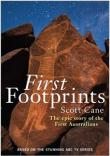
Latest Issues
AbstractHistoryArchive Description
'First Footprints tells the epic story of Australia's Aboriginal people. It is a story of ancient life on the driest continent on earth through the greatest environmental changes experienced in human history: ice ages, extreme drought and inundating seas. It is chronicled through astonishing archaeological discoveries, ancient oral histories and the largest and oldest art galleries on earth. Australia's first inhabitants were the first people to believe in an afterlife, cremate their dead, engrave representations of the human face, and depict human sound and emotion. They created new technologies, designed ornamentation, engaged in trade, and crafted the earliest documents of war. Ultimately, they developed a sustainable society based on shared religious tradition and far-reaching social networks across the length and breadth of Australia. ' (Source: Publishers website)
Adaptations
-
form
y
 First Footprints
Tania Nehme
(editor),
Peter Donoughue
(editor),
( dir. Bentley Dean
et. al. )agent
Artarmon
:
Screen Australia
,
2013
7352315
2013
film/TV
First Footprints
Tania Nehme
(editor),
Peter Donoughue
(editor),
( dir. Bentley Dean
et. al. )agent
Artarmon
:
Screen Australia
,
2013
7352315
2013
film/TV
'First Footprints tells the story of the original pioneers for all humankind, a history that began in Australia tens of thousands of years before modern humans reached America or Europe. The series draws on the collective memory of Indigenous Australians, the latest archaeological discoveries and the rich record of over 30 million prehistoric painted and etched rocks. Along with evocative recreations, elegant CGI, grand landscape and a wealth of rare archival footage the series will expand our ideas. Sweeping from 60,000 years ago to 1788, each episode begins and ends with a cataclysmic event that transforms life in Australia.' (Source: TROVE)
Publication Details of Only Known VersionEarliest 2 Known Versions of
Other Formats
- Also electronic source
Works about this Work
-
[Review Essay] : First Footprints: The Epic Story of the First Australians
2014
single work
review
— Appears in: Australian Aboriginal Studies , no. 1 2014; (p. 144-147)
— Review of First Footprints : The Epic Story of the First Australians 2013 single work criticism'The story of the movement of Aboriginal peoples into what is now Australia some 70,000 years ago and their survival over tens of thousands of years is, as Scott Cane says in this book, truly epic. The story of these achievements is not new, but the way it is told in First footprints is. Scott Cane’s new book demonstrates, through a survey of archaeological evidence, the extraordinary diversity, adaptability and innovative skills of Australia’s Indigenous peoples as they moved into and settled throughout this continent. Their superb skills enabled these people to adapt their technologies, cultural expressions, traditions and lifestyles over time in the context of immense climatic and environmental changes. I discussed some aspects of these innovative skills of Aboriginal people in my 2007 book Writing heritage: the depiction of Indigenous heritage in European–Australian writings. Innovations in material culture included modifying stone and wooden tools in form, size and function, introducing new designs or entirely new objects, or even ceasing use of some items if circumstances no longer required them. Then, of course, there was the incorporation of introduced European materials into their toolkit — wire, steel and glass, for example. There were innovations in subsistence strategies, foods and living conditions. Cane brings out all these and much more in the way of innovative and adaptive strategies that Indigenous people employed over time and place, across the entire range of their cultural and societal systems.' (Introduction)
-
[Review Essay] : First Footprints: The Epic Story of the First Australians
2014
single work
review
— Appears in: Australian Aboriginal Studies , no. 1 2014; (p. 144-147)
— Review of First Footprints : The Epic Story of the First Australians 2013 single work criticism'The story of the movement of Aboriginal peoples into what is now Australia some 70,000 years ago and their survival over tens of thousands of years is, as Scott Cane says in this book, truly epic. The story of these achievements is not new, but the way it is told in First footprints is. Scott Cane’s new book demonstrates, through a survey of archaeological evidence, the extraordinary diversity, adaptability and innovative skills of Australia’s Indigenous peoples as they moved into and settled throughout this continent. Their superb skills enabled these people to adapt their technologies, cultural expressions, traditions and lifestyles over time in the context of immense climatic and environmental changes. I discussed some aspects of these innovative skills of Aboriginal people in my 2007 book Writing heritage: the depiction of Indigenous heritage in European–Australian writings. Innovations in material culture included modifying stone and wooden tools in form, size and function, introducing new designs or entirely new objects, or even ceasing use of some items if circumstances no longer required them. Then, of course, there was the incorporation of introduced European materials into their toolkit — wire, steel and glass, for example. There were innovations in subsistence strategies, foods and living conditions. Cane brings out all these and much more in the way of innovative and adaptive strategies that Indigenous people employed over time and place, across the entire range of their cultural and societal systems.' (Introduction)


